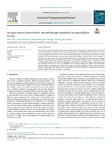An Open-Source Framework for Aircraft Damage Simulation in Engine Failure Events

Use this link to cite
http://hdl.handle.net/2183/31004
Except where otherwise noted, this item's license is described as Atribución-NoComercial-SinDerivadas 4.0 Internacional
Collections
- Investigación (ETSECCP) [826]
Metadata
Show full item recordTitle
An Open-Source Framework for Aircraft Damage Simulation in Engine Failure EventsDate
2022Citation
Cid, C., Baldomir, A., Rodríguez-Segade, M., Hernández, S. (2022). An open-source framework for aircraft damage simulation in engine failure events. Journal of Computational Science, 101682. ISSN 1877-7503,
https://doi.org/10.1016/j.jocs.2022.101682.
(https://www.sciencedirect.com/science/article/pii/S1877750322000904)
Abstract
[Abstract] The aerospace industry demands designs capable of withstanding the simultaneous collapse of several structural elements. Examples of this failure scenario are propeller blade or uncontained engine rotor failures, where the structural integrity of the aircraft may be compromised by flying debris. To assess aircraft survivability, reliable simulation of accidental damage scenarios using physics-based models is required. Due to the complexity of characterizing these events, practitioners and researchers have traditionally assumed conservative damage envelopes, restraining potential design improvements. This research presents an object-oriented framework to automatically generate any number of damaged aircraft meshes in a realistic manner, taking into account the randomness of the event. Due to the flexibility in the software design, both random and deterministic input parameters are allowed, such as debris origin, impact orientation, number of impacts, debris size, debris velocity, spread angles and ballistic penetration equations. The tool is applied to a commercial narrow-body aircraft in which real failure scenarios are simulated.
Keywords
Fail-safe
Damage
Uncontained engine rotor failure
Propeller blade failure
Debris
Damage
Uncontained engine rotor failure
Propeller blade failure
Debris
Description
Financiado para publicación en acceso aberto: Universidade da Coruña/CISUG
Editor version
Rights
Atribución-NoComercial-SinDerivadas 4.0 Internacional






